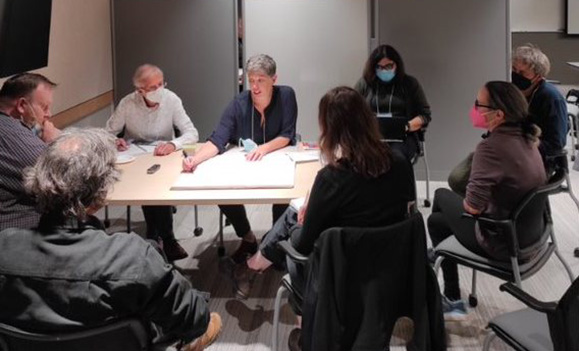 Our connection to the land we live on is emotional. Humans are territorial by nature. But what happens when climate change forces hard questions about our continued ability to inhabit the places we call home? What happens when we push nature so hard that it begins to push us back ŌĆö and out?
Our connection to the land we live on is emotional. Humans are territorial by nature. But what happens when climate change forces hard questions about our continued ability to inhabit the places we call home? What happens when we push nature so hard that it begins to push us back ŌĆö and out?
├└┼«ū÷░« researcher Dr. Kate Sherren spends most of her time trying to answer these questions. The environmental social scientist focuses on how people are experiencing climate-related changes to their coasts and how they respond.
An emotional reaction
Dr. Sherren says our emotional connection to the places we live can make us prone to bad choices, whether we live near forests turned tinder dry by drought, or in ocean settlements vulnerable to sea-level rise and extreme weather events.
ŌĆ£A lot of the work I've done is with coastal communities to try to understand how they see changes taking place in their landscapes, and if there's space for nature-based approaches to reducing risk in the face of climate change,ŌĆØ says Dr. Sherren.
ŌĆ£It's methodologically very broad,ŌĆØ she says about her research that employs interviews, focus groups, surveys, and social media analysis to get into the heads of those living near the ocean. ŌĆ£The core of it is focused on understanding how people are perceiving and responding to global change, and particularly coastal change.ŌĆØ
Transformational Climate Action

Emerging science reveals the ocean's ability to absorb CO2 and regulate temperatures is changing in ways we donŌĆÖt understand. These critical shifts are not accounted for in climate targets ŌĆō a risk we can no longer take. With support from the Canada First Research Excellence Fund, ├└┼«ū÷░« is leading an ocean-first approach to tackle climate change and equipping Canada with the knowledge, innovations, and opportunities to secure a positive climate future.
.

Dr. Sherren meets with coastal decision-makers from across Nova Scotia. (Provided photo)
A line in the sand
Through her research, Dr. Sherren tries to gauge receptivity to protection techniques such as restoring more wetlands in areas like CanadaŌĆÖs Bay of Fundy, which can provide natural buffers. But she is also trying to understand what it will take to gain acceptance of solutions that may be harder to swallow, including retreating from coastlines altogether.
ŌĆ£We need to be coastal in a different way,ŌĆØ says Dr. Sherren. ŌĆ£We need to learn that the lines we laid down at one time cannot necessarily be defended. We have to make some tough decisions together about where we can defend, where we should defend, and where we should actually pull back and leave space for ocean dynamism.ŌĆØ

Dr. Sherren surveys a coastal floodplain. (Photo provided)
Thirsty for information
She says the more we know about the factors that drive climate and ocean change, the better we can help communities along coastlines in Canada and around the world understand and adapt. As part of the Transforming Climate Action research team, Dr. Sherren will be able to leverage discoveries about the oceanŌĆÖs role in climate change and its shifting dynamics to help steer community engagement and policy recommendations.
ŌĆ£Coastal communities have a thirst for this kind of information. For them, there's still an enormous amount of uncertainty,ŌĆØ says Dr. Sherren. ŌĆ£We think, in our hearts, that we're going to have time to make decisions, we think that the change is going to be gradual and that it's going to become clear when we need to cut and run, or to adapt and pull back.ŌĆØ
But she says that extreme weather events, such as the recent hurricane Fiona that hit CanadaŌĆÖs east coast, demonstrate that the time for action is already upon us. The ocean and climate are observably changing and, as part of the Transforming Climate Action research consortium, Dr. Sherren aims to help shape the policy, engagement and action needed to keep communities safe.
Natural solutions
Dr. Sherren says emotions still play an important role, even in the face of facts. She warns that threatened communities are often convinced that dikes and walls are the best means of protection. But, she says, itŌĆÖs not realistic to think we can build interventions to protect every vulnerable coastline. And, even if we did, many wouldnŌĆÖt stand a chance against sea level rise or increasingly destructive weather events.

╠²Ocean fronts are changing. Dr. Sherren says we need to change with them.╠²(Adam Hill photo)
This is why Dr. Sherren is a proponent of re-establishing natural defences such as wetlands that create a buffer against rising tides and storm surges. ŌĆ£Nature-based approaches have a self-healing function. Tidal wetlands can often grow and raise themselves as sea levels rise,ŌĆØ she says.
ŌĆ£We're used to the illusion that we're protected by dikes and walls, even though they can fail spectacularly. We need to get used to the idea that there can be a softer coastline in front of us that can keep us safe.ŌĆØ
Moreover, she says we need to get used to the fact that humans might need to clear out of some areas to create space for softer and safer coastlines.
ŌĆ£The beach and the shoreline belong to the ocean,ŌĆØ says Dr. Sherren. ŌĆ£I think we've gotten used to the idea that they're ours. But they're not.ŌĆØ

